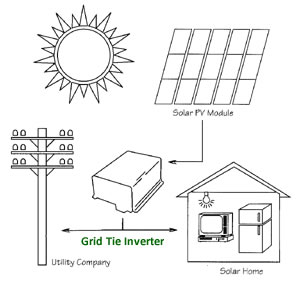What is a power inverter?
The basic function of a solar powered inverter is to convert the direct current to alternating current. Solar panels, and in fact almost all eco-friendly power sources such a wind turbines, generate “direct current”. But almost everything that makes up the fabric of
civilization runs on alternating current. Current flows from a battery or solar cell in one direction, but an alternating current stream reverses direction 60 times each second. While this may seem wasteful, the detailed physics of the situation mean the alternating current can be sent over longer distances more efficiently that direct current. Don’t worry if the advantages of AC current do not seem obvious - even Thomas Edison was uncomfortable with alternating current! Suffice it to say that almost all the devices in your home; motors, appliances, televisions, use alternating current.
What is a grid tie power inverter?

The main difference between a standard power inverter and a grid tie power inverter is that the latter also ensures that the power supplied will be in phase with grid power. This allows individuals with surplus power (wind, solar, etc) to sell the power back to the utility in the form of net metering or the arrangement your local utility offers.
On the AC side a grid tie inverter must supply electricity in sinusoidal form, synchronized to the frequency of the grid and limit the feed in voltage to no higher than the grid voltage. A grid tie inverter also must disconnect from the grid if the utility grid goes down (blackout). In the event of a blackout, the grid tie inverter will shut down to prevent potentially harming the line workers who are sent to fix the power grid. See wikipedia article on
grid tie inverters.
On the DC side, the power output of a module varies as a function of the voltage in a way that power generation can be optimized by varying the system voltage to find the 'maximum power point'. Most inverters therefore incorporate 'maximum power point tracking' (MPPT).
How Solar Powered Inverters and Alternating Current work
The alternating current we usually need to get from our solar powered inverter needs to match the alternating current from our electrical utility. This current alternates because it is produced by rotating electrical generators. Current flows when a coil of wire passes thru a magnetic field. Generators are designed to pass coils of wire thru a magnetic field as they spin, so the current actually leaves, and then returns, to the power plant. As it happens, by using alternating current, the system can be designed for higher voltage and lower current, allowing more power to move thru the grid with less loss to heat.
Current is what causes energy to be wasted in power transmission thru wire. To reduce this ‘line drop’ loss, the voltage applied at the power plant which drives this current can be rather high. Along the way to your house, the voltage is ‘dropped’ in a series of transformers which can be thought of as big coils of wire, almost as a generator with no moving parts.
A solar powered inverter, like any inverter, converts steady direct current from a solar cell or battery to a smooth oscillating sine wave by switching the DC power on and off, very quickly. As a rough cut, switching the DC power 60 times a second creates what is called a ‘square’ wave. But if we subtract out power switched 180 times a second we can ‘round the corners’ of the square’ a bit. And by further switching in power at 300 and out at 420 times a second an inverter can approach a smooth AC wave quite closely. Some electrical components (capacitors and inductors) used on the AC Side of the inverter can store and discharge a bit of power as the many square waves pass, further smoothing out the stack of square waves and approximate regular AC Power.

